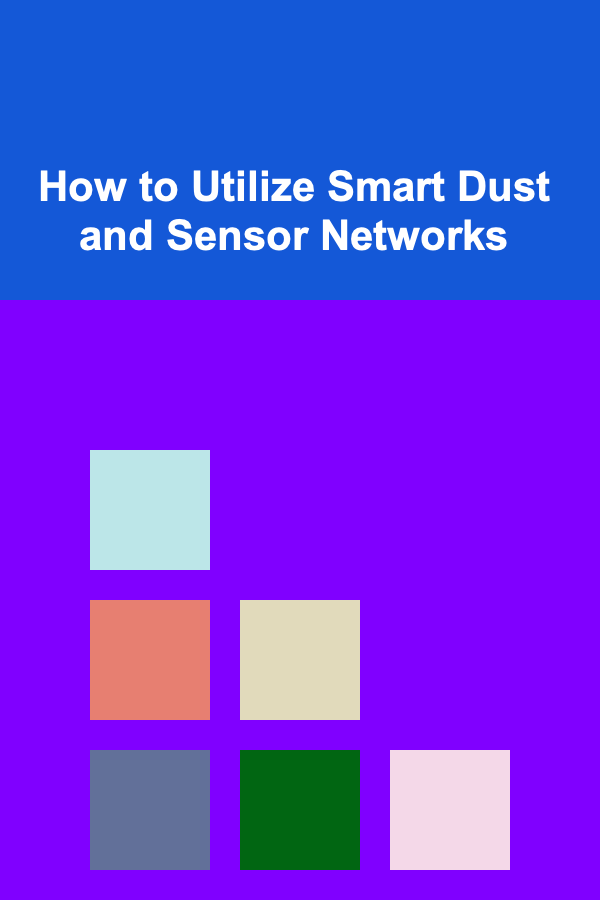
How to Utilize Smart Dust and Sensor Networks
ebook include PDF & Audio bundle (Micro Guide)
$12.99$11.99
Limited Time Offer! Order within the next:

The world is rapidly evolving toward a more interconnected and intelligent environment, where data and information flow seamlessly to make smarter decisions. Central to this transformation are technologies like smart dust and sensor networks, which have become integral to various industries, including healthcare, agriculture, urban development, and environmental monitoring. These technologies promise to revolutionize how we interact with the world by providing unprecedented amounts of real-time data. This article explores the concepts of smart dust and sensor networks, their applications, challenges, and potential future impact.
What is Smart Dust?
Smart dust refers to tiny, wireless sensors that can detect environmental changes and communicate with each other over a network. These micro-sensors, often smaller than a grain of sand, are capable of monitoring various physical phenomena such as temperature, humidity, light, motion, and chemical composition. Smart dust is typically composed of micro-electromechanical systems (MEMS), which combine sensors, actuators, and communication devices in a compact form.
1.1 The Evolution of Smart Dust
The concept of smart dust was first introduced by K. S. J. Pister, a professor at the University of California, Berkeley, in the late 1990s. His idea was to create a network of microscopic sensors that could be scattered across large areas to collect data. Over the years, advances in microfabrication, wireless communication, and energy harvesting have brought this vision closer to reality.
The key to smart dust's utility lies in its ability to monitor and report on a variety of physical, chemical, and environmental parameters. These sensors are typically powered by energy harvesting techniques, such as converting light or mechanical vibrations into electrical energy, enabling them to operate without the need for batteries.
1.2 Components of Smart Dust
Smart dust systems typically consist of the following components:
- Sensors: These measure environmental parameters like temperature, pressure, humidity, light, and motion.
- Microprocessors: These process the data collected by sensors and prepare it for transmission.
- Communication Systems: Smart dust devices use short-range communication protocols (such as Bluetooth, Zigbee, or Wi-Fi) to send data to nearby nodes or base stations.
- Energy Harvesters: These collect ambient energy (e.g., solar energy, thermal energy, or vibrations) to power the sensors and microprocessors.
Sensor Networks: The Backbone of Smart Dust
A sensor network is a group of spatially distributed sensors that collect data from the environment and transmit it to a central processing system. These networks are the infrastructure that enables smart dust devices to function efficiently. Sensor networks can be categorized into various types, depending on their design and application.
2.1 Types of Sensor Networks
There are several types of sensor networks, each optimized for specific tasks:
- Wireless Sensor Networks (WSNs): These networks consist of numerous sensor nodes that communicate wirelessly. WSNs are commonly used in monitoring systems where data needs to be transmitted over long distances, such as environmental monitoring or industrial applications.
- Body Area Networks (BANs): These are sensor networks designed for healthcare applications. They involve wearable sensors that track vital signs like heart rate, blood pressure, and temperature. These networks are typically used in medical devices or remote patient monitoring.
- Internet of Things (IoT) Networks: IoT networks involve sensor nodes integrated into everyday objects, allowing them to collect and share data via the internet. This setup has become a key feature of smart cities, autonomous vehicles, and home automation systems.
- Ad-hoc Sensor Networks: These networks are dynamically formed for specific applications. They are often temporary and self-configuring, with nodes establishing communication as needed. They are useful for search and rescue operations or military applications.
2.2 Key Features of Sensor Networks
Sensor networks offer several advantages that make them suitable for a wide range of applications:
- Scalability: Sensor networks can scale from a few sensors to millions of nodes, depending on the application requirements.
- Real-time Monitoring: These networks are capable of providing real-time data, enabling immediate responses to environmental changes.
- Energy Efficiency: With advances in low-power communication protocols and energy harvesting technologies, sensor networks can operate in remote locations for extended periods without requiring frequent battery replacements.
- Autonomous Operation: Sensor networks can operate autonomously, with sensors detecting environmental changes and transmitting data without human intervention.
2.3 Communication Protocols for Sensor Networks
Sensor networks rely on various communication protocols to transmit data between sensor nodes and central systems. Some of the common protocols include:
- Zigbee: A low-power, low-data-rate protocol designed for short-range communication. Zigbee is ideal for sensor networks in smart homes, industrial automation, and healthcare applications.
- LoRaWAN: A long-range, low-power protocol that is widely used in IoT and smart city applications. LoRaWAN enables communication over distances of up to 15 km in rural areas.
- Bluetooth Low Energy (BLE): BLE is used for short-range communication between devices and is commonly found in wearable devices and healthcare applications.
- Wi-Fi and 5G: These high-bandwidth communication protocols are used for real-time data transmission in high-density environments, such as urban centers or smart factories.
Applications of Smart Dust and Sensor Networks
The potential applications of smart dust and sensor networks are vast and span multiple industries. These technologies are being used to solve complex problems, improve efficiency, and enhance safety across various domains.
3.1 Environmental Monitoring
One of the most significant applications of smart dust and sensor networks is in environmental monitoring. Smart dust can be deployed in large numbers to monitor air quality, pollution levels, temperature, humidity, and even chemical contaminants in real-time. These sensors can provide critical data for managing climate change, predicting natural disasters, and monitoring ecosystems.
- Air Quality Monitoring: Smart dust sensors can be used to measure particulate matter (PM), nitrogen dioxide (NO2), carbon monoxide (CO), and other harmful gases in the air, providing early warnings about pollution spikes and enabling better air quality management.
- Soil and Water Monitoring: In agriculture, smart dust can monitor soil moisture, pH levels, and temperature to optimize irrigation systems, reducing water waste and improving crop yields. In water bodies, these sensors can detect pollutants and other harmful substances, alerting authorities to contamination risks.
3.2 Healthcare and Disease Detection
Smart dust and sensor networks are playing a pivotal role in healthcare by enabling remote monitoring and early detection of diseases. These systems can track a person's vital signs, such as heart rate, blood pressure, glucose levels, and respiratory rate, in real-time.
- Wearable Health Devices: Smart dust can be embedded in wearable devices, providing continuous monitoring of patients' health conditions. For instance, it can track heart conditions in individuals with cardiovascular disease or monitor glucose levels in diabetic patients.
- Remote Patient Monitoring: Sensor networks can be deployed in homes or hospitals to monitor patients' health without the need for constant visits. Data collected by sensors can be sent to healthcare professionals, allowing for timely interventions.
- Early Disease Detection: Smart dust sensors can detect environmental factors that contribute to the spread of diseases, such as viruses or bacteria. In addition, they can be used to track environmental changes linked to the emergence of epidemics.
3.3 Industrial Applications
In industrial settings, smart dust and sensor networks are enhancing operational efficiency, improving safety, and enabling predictive maintenance.
- Smart Factories: By integrating smart dust into industrial machinery, manufacturers can monitor the condition of equipment and detect early signs of wear and tear. This helps reduce downtime and optimize the use of resources.
- Predictive Maintenance: Sensors can detect abnormal vibrations, temperature fluctuations, or pressure changes in machinery, allowing maintenance teams to perform repairs before equipment failure occurs, thereby saving costs and improving safety.
- Asset Tracking: Sensor networks are used in warehouses to track inventory and assets, reducing theft and improving operational efficiency.
3.4 Agriculture and Precision Farming
In precision farming, smart dust can provide real-time data on soil conditions, crop health, and weather patterns, enabling farmers to make data-driven decisions.
- Crop Monitoring: Smart dust sensors can detect the moisture content of soil and the growth conditions of crops, allowing farmers to adjust irrigation systems and apply fertilizers more effectively.
- Livestock Monitoring: Sensor networks can track the health and location of livestock, ensuring their well-being and improving overall farm management.
3.5 Urban Development and Smart Cities
In smart cities, sensor networks are crucial for enhancing the quality of life by optimizing urban services, improving energy efficiency, and enhancing public safety.
- Traffic Management: Smart dust and sensor networks can be used to monitor traffic flow, reduce congestion, and improve traffic light management, leading to more efficient transportation systems.
- Waste Management: Sensors can be used to monitor waste levels in bins and optimize collection schedules, reducing operational costs and improving city cleanliness.
- Public Safety: Sensors can detect environmental hazards, such as gas leaks, fires, or accidents, and send alerts to emergency services, helping them respond quickly to incidents.
Challenges and Limitations
Despite their potential, there are several challenges that hinder the widespread adoption of smart dust and sensor networks.
4.1 Privacy and Security
Given the vast amount of data collected by smart dust sensors, ensuring the privacy and security of this data is a significant concern. Unauthorized access to sensor data could lead to privacy violations, identity theft, and even cyber-attacks.
4.2 Scalability and Maintenance
Building and maintaining large-scale sensor networks can be complex and expensive. As the number of nodes in a network grows, the challenges of ensuring reliable communication, data consistency, and battery life become more significant.
4.3 Data Management
The massive amounts of data generated by smart dust and sensor networks require sophisticated data management techniques. Storing, processing, and analyzing this data can be resource-intensive and may require the use of advanced cloud computing and AI techniques.
4.4 Power Consumption
Although energy harvesting technologies are improving, the power requirements for operating large sensor networks can still be a limitation, especially in remote or difficult-to-reach areas.
The Future of Smart Dust and Sensor Networks
As technology advances, the future of smart dust and sensor networks looks promising. With developments in artificial intelligence (AI) , machine learning , and 5G networks, these systems will become more efficient, scalable, and capable of handling larger amounts of data. Furthermore, new energy harvesting methods and battery technologies may alleviate current power limitations, enabling sensors to operate for even longer periods.
In the future, smart dust and sensor networks will likely be embedded in a wide range of applications, from autonomous vehicles to climate change monitoring, and even in space exploration.
Conclusion
Smart dust and sensor networks are transformative technologies that hold the potential to revolutionize numerous industries. By enabling real-time data collection and communication, these systems will drive innovation in environmental monitoring, healthcare, agriculture, and urban development. However, the widespread adoption of these technologies will require overcoming significant challenges, such as privacy concerns, scalability, and power limitations.
As research and development in this field continue, smart dust and sensor networks will likely become an integral part of the interconnected world of the future, helping to create smarter, more efficient, and more sustainable systems.

How to Clean and Maintain Your Home Appliances
Read More
How to Design a One-Page Website That Converts Visitors Into Clients
Read More
How to Make Money Online as a Vintage Item Seller: 10 Actionable Ideas
Read More
How to Master Conflict and Tension in Storytelling
Read More
How to Conquer Your Fear of the Elements
Read More
10 Tips for Preserving Your Foraged Finds
Read MoreOther Products

How to Clean and Maintain Your Home Appliances
Read More
How to Design a One-Page Website That Converts Visitors Into Clients
Read More
How to Make Money Online as a Vintage Item Seller: 10 Actionable Ideas
Read More
How to Master Conflict and Tension in Storytelling
Read More
How to Conquer Your Fear of the Elements
Read More